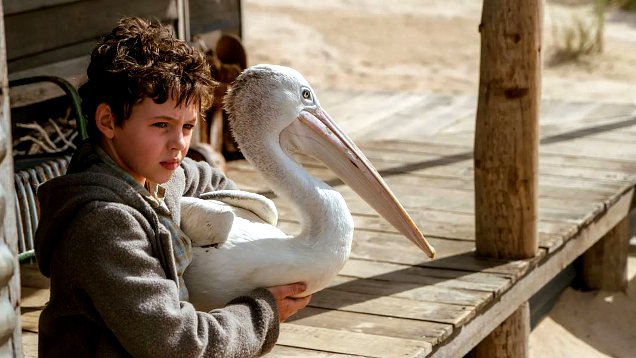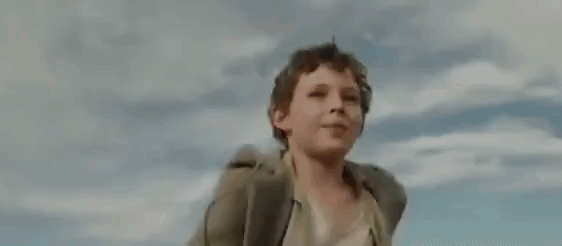Storm Boy looks nice but has a plot that could have been lifted from a discarded Lassie script

The original 1976 Storm Boy film is a beautiful experience – but sadly the reboot is a different kettle of fish, writes critic Travis Johnson.
There’s merit in the idea of remaking Storm Boy, if not the execution. The last at bat was in 1976, when director Henri Safran crafted a minor – yet beloved – classic of Australian cinema out of Colin Thiele’s 1964 children’s novel. Unfortunately, judging by Shawn Seet’s 21st century effort, that may not be a trick that can be pulled off twice.
Set on a remote, rugged stretch of South Australian coastline, Storm Boy (all versions) is the story of the titular lad, aka Mike Kingsley (Finn Little), who lives in a ramshackle hut with his hermit father, Hideaway Tom (Jai Courtney), who has walked away from the modern world following the death of his wife and daughter in a car accident. The loneliness of their life suits the grief-stricken Tom, but Mike is a bright, precocious kid who would benefit from an education more complex than how to gut fish.
But the dramatic crux of the story is young Mike’s attempts, with the help of local Indigenous man Fingerbone Bill (Trevor Jamieson), to raise three orphaned pelican chicks, who he dubs Mr. Proud, Mr. Ponder and Mr. Percival. It’s a coming of age tale, with Mike’s experiences with the birds, Bill, and his own father teaching him vital lessons about life and death, the land, and our connection with it.
Unfortunately, we know this because Geoffrey Rush tells us so. Storm Boy ’19 is saddled with a clumsy framing device in which Rush, playing the aged Mike, narrates the story of his childhood to his granddaughter Madeline (Morgana Davies). Now the CEO of a large, vaguely defined corporation, Mike is having pangs of conscience due to his company planning on some kind of ecologically unsound project in Western Australia’s Pilbara region, and only deep reflection on the lessons of his childhood will stop the needle on his moral compass from spinning.

It’s a deeply awkward narrative element that raises far more questions than it answers and seems to have been added in the mistaken assumption that Storm Boy needed some tangible connection to the modern day to make it relevant. It doesn’t – the story is timeless, and it’s disconcerting that those in charge of stewarding the story back onto the big screen seem to think otherwise.
But other changes support the notion that director Shawn Seet and screenwriter Justin Monjo lack faith in Thiele’s source material, a school reading list perennial for good reason. What was subtle and understated on the page and in the ’76 adaptation is rendered obvious here, and the story’s themes are made literal. One of the less egregious but more obvious is the presence of two bird hunters, a threat to the lives of the pelicans whose leering evil would not look out of place in some decrepit old Australian children’s adventure TV series – Ship to Shore, maybe, or Secret Valley. In the world of Storm Boy ’19 fishermen like Hideaway Tom are implicitly Good, bird hunters are implicitly Evil – a moral distinction that makes little sense after a moment’s contemplation.
The thing is, as a novel Storm Boy might be aimed at juveniles, but it’s not a juvenile work. That important point of difference does not carry over to this new adaptation, whose climax – and we’re drifting dangerously close to spoiler territory here – could have been lifted from a discarded Lassie reboot script.
In a pretty egregious bit of false tension, the redoubtable Mr. Percival, already anthropomorphised to an absurd degree, is called on to perform a bit of derring-do that would tax even the most well-trained Border Collie, let alone a bird with a brain the size of a chicken nugget. It’s an unintentionally hilarious sequence, made all the more so by the fact that it arises not out of the established drama of the film, but is roughly inserted into the story because well, it’s about time we had a bit of action, isn’t it?
That kind of ham-fisted approach is evident throughout the film, but it’s not all bad news. The cast acquit themselves very well considering what they’ve got to work with. Finn Little is incredibly engaging and naturalistic in the title role, while Jai Courtney’s take on the gruff, taciturn Tom is leavened with good-natured charm. The standout, however, is Trevor Jamieson as Fingerbone Bill, who effortlessly communicates hidden depths and a long personal history with barely a word.
On a technical level, Storm Boy generally impresses, with Bruce Young’s evocative cinematography a particular standout, capturing the stark beauty of the southern ocean, the windswept dunes and iron-grey palings, and the simple wonder of birds in flight and foaming waves. It’s not that the film doesn’t look good – it simply doesn’t read well. Rush’s elder Mike might be compromised and lost when Storm Boy opens, but he finds his way home eventually. The film he’s in never does.

















